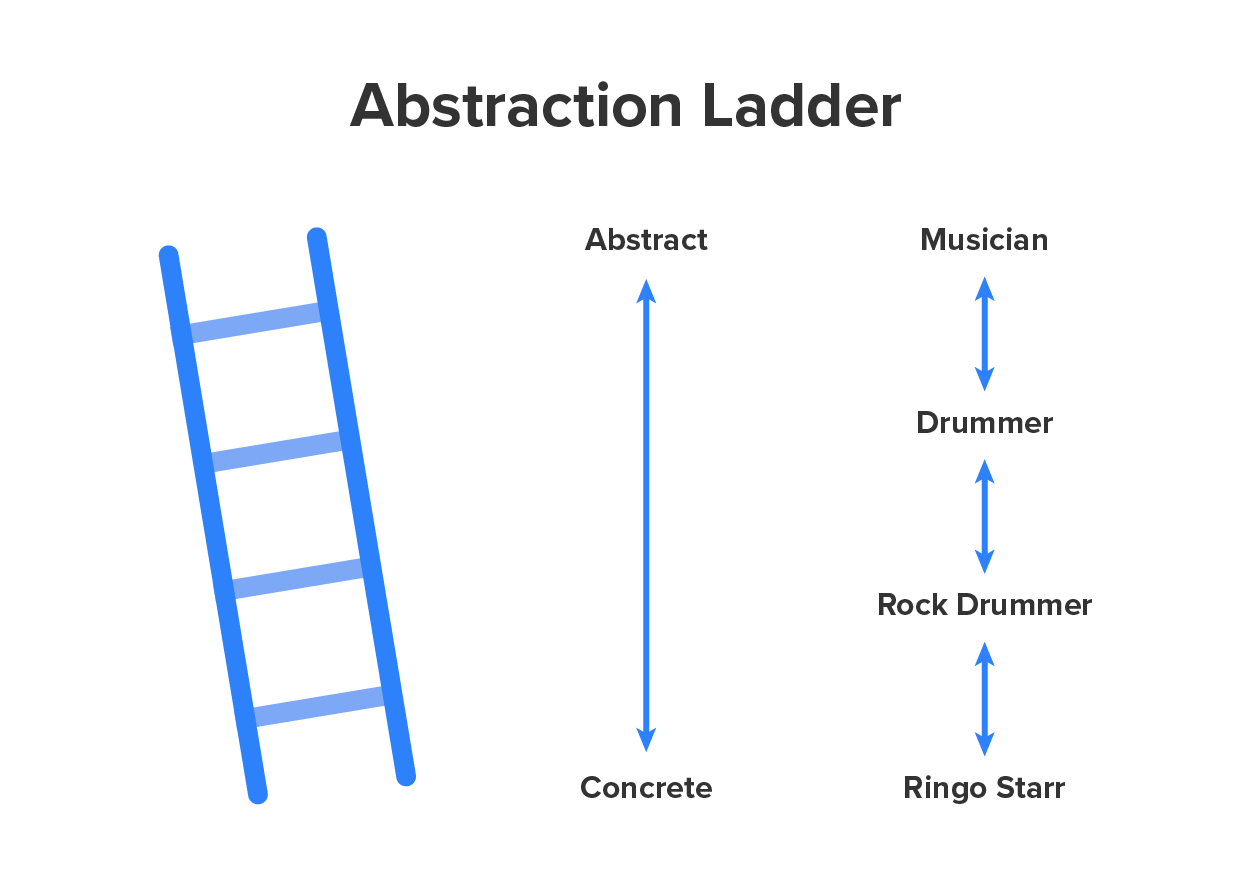Table of Contents |
Abstraction is the process of perceiving similarities from our direct, specific observations in the universe, organizing the similarities, and then assigning a word label for the more general concept.
The ability to simplify experiences with a word makes it easier to communicate, but it also makes us lose the connection to the specific meaning that we want to convey through abstract wording.
Imagine you see several different objects and notice something similar about all of them, such as their color. You can take this one characteristic, the color, and give it a label—for example, red.
You have directly observed the objects and noticed color in them. Then, you give the color you see a label: red.
For your audience, the label red is not necessarily connected with the objects you saw, because they did not see these objects or create this label themselves. However, the audience may have seen similar objects and learned to assign the same label, red, to the color.
We group together all the similar experiences to form a higher-level concept, which includes all the specific, individual observations we are engaging in abstraction.
Almost anything can be described either in relatively abstract, general words or in relatively concrete, specific ones.
S. I. Hayakawa explained the concept using a ladder.

EXAMPLE
You may say that you are writing on a piece of electronic equipment or that you are writing on a laptop computer. You may say that your company produces consumer goods or that it makes cell phones. When groups of words are ranked according to degree of abstraction, they form hierarchies.In general, as you move from one level to another while speaking, you will tailor the level of abstraction to the specific speech content and the audience’s level of understanding.
You can increase the clarity, and therefore the usability, of your speaking by using concrete, specific words rather than abstract, general ones. Concrete words help your audience understand precisely what you mean.
EXAMPLE
If you say that you want to produce television shows for a younger demographic segment, they won't know whether you mean teenagers or toddlers. If you say that you study natural phenomena, your audience won't know whether you mean volcanic eruptions or the migrations of monarch butterflies.Such vagueness can hinder the audience from getting the information they need in order to make decisions and take action. When you want the audience to make a concrete connection to their direct experience, remember to come down to earth on the abstraction ladder. You can move up the ladder again to talk about broader concepts.
For example, you will draw heavily on level one to create images of specific people, places, or things in the minds of your audience. You may move up and down the level of abstraction as needed.
EXAMPLE
If you are talking about a top-level abstraction such as transportation, you may need to make it real for the audience by describing actual means of transportation, such as your green mountain bike for city use or your blue and silver BMW for longer trips.Abstract and general terms do have important uses for different audiences and occasions. For example, in scientific, technical, and other specialized fields, speakers often need to make general points, describe the general features of a situation, or provide general guidance for action.
Use abstract and specialized terminology to communicate economically. Specialized, abstract terminology only works when your audience understands them. You can use the specialized terminology of a particular profession or group if you know that they already have specific connections to the more abstract terminology.
With audiences who understand abstractions, the technical meanings can communicate messages economically with fewer words than if you started with specific instances at the bottom of the abstraction ladder.
Your objective when choosing words is not to avoid abstract, general words altogether, but rather to avoid using them when your audience needs more specific, concrete connections to what you are saying.
Source: THIS TUTORIAL HAS BEEN ADAPTED FROM "BOUNDLESS COMMUNICATIONS" PROVIDED BY BOUNDLESS.COM. ACCESS FOR FREE AT oer commons. LICENSE: CREATIVE COMMONS ATTRIBUTION-SHAREALIKE 4.0 INTERNATIONAL.